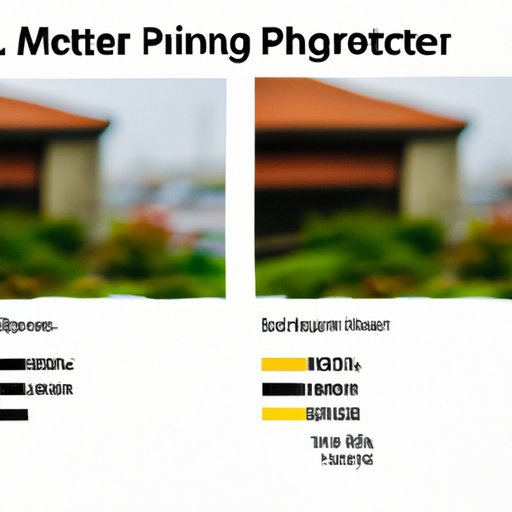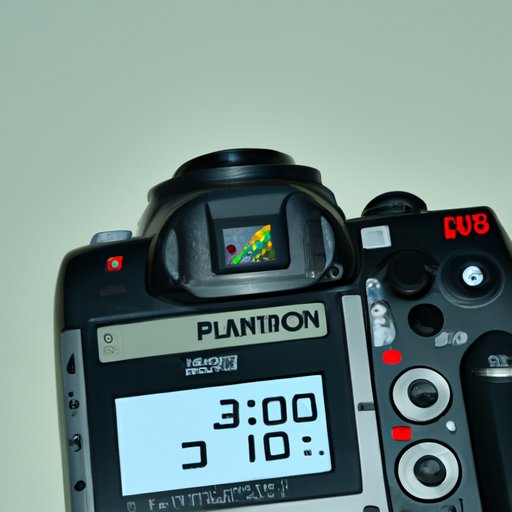An Overview of Metering in Photography
Metering is a critical element of photography that helps photographers make sure they are achieving the desired results with each shot. It is the process of measuring the amount of light available in a scene in order to determine the best settings for the camera. By understanding how to properly use metering, photographers can create stunning images.
Definition of Metering
Metering is the process of gauging the amount of light that is present in a scene in order to determine the best settings for the camera. The camera’s light meter will measure the amount of light reflected from the subject and then calculate the appropriate exposure settings for that particular scene.
Different Types of Meters
Most cameras have three main types of meters: spot, center-weighted, and evaluative/matrix metering. Each type of metering measures light differently and has its own advantages and disadvantages.
Exploring the Different Types of Metering
Spot metering is the most precise type of metering. It measures only a small area of the scene and is ideal for when you want to accurately expose a specific part of the image. Spot metering is typically used for backlit subjects or where there is a large contrast between the highlights and shadows.
Center-weighted metering works by taking into account the light in the entire frame but giving more importance to the center of the frame. This type of metering is useful for portraits or landscapes where the main subject is in the center of the frame. It is also a good choice for scenes with even lighting.
Evaluative/matrix metering is the most common type of metering. It takes into account all of the light in the frame and divides it into multiple zones. It then uses an algorithm to calculate the optimal exposure settings for the scene. Evaluative/matrix metering is great for capturing evenly lit scenes or for situations where the light is constantly changing.

The Benefits of Using Metering in Photography
Using metering in photography has several important benefits. Firstly, it helps to ensure proper exposure. Without metering, it would be difficult to determine the correct settings for the camera in order to achieve the desired results. Secondly, it allows photographers to achieve their desired results. By using the meter, photographers can determine the best settings for the camera so that they get the exact look and feel that they are trying to achieve.

How to Use Metering for Creative Results
In order to use metering for creative results, photographers need to understand light and contrast. They should pay attention to the highlights and shadows in the scene and adjust the settings accordingly. Additionally, they should take into account the shutter speed and aperture settings, as well as utilize any filters that may be necessary.
For example, if a photographer is shooting a portrait and wants to darken the background, they can use a neutral density filter to reduce the amount of light entering the lens. This will help to create a darker background while still allowing the subject to be properly exposed.
Tips and Tricks for Accurate Metering
To ensure accurate metering, photographers should use the bracketing technique. This involves taking multiple shots at different exposure settings and then analyzing the results to see which one looks best. Additionally, they should pay attention to the camera’s histogram and make adjustments as needed. Finally, they should always take into account the background when metering.
For instance, if the background is much brighter than the subject, the meter may be fooled into underexposing the image. To avoid this, photographers can use a gray card to help set the correct exposure.

Common Mistakes to Avoid When Metering
When metering, it is important to avoid making common mistakes. These include over-exposure, underexposure, and not taking into account the lighting conditions. Over-exposure occurs when too much light is allowed into the camera and can result in washed out colors and blown out highlights. Underexposure occurs when too little light is allowed into the camera and can result in dark, flat images. Finally, not taking into account the lighting conditions can lead to inaccurate metering.

How to Use Manual Metering in Low Light Situations
When shooting in low light situations, it is often best to switch to manual metering. This involves manually setting the exposure settings for the camera instead of relying on the camera’s meter. In these situations, photographers should increase the ISO settings, slow down the shutter speed, and use the aperture priority mode.
For example, if a photographer is shooting a night time cityscape, they can increase the ISO to 1600 and set the shutter speed to 1/15th of a second. They can then use the aperture priority mode to set the aperture to f/8 in order to get the desired depth of field. This will ensure that the image is correctly exposed.
Conclusion
Metering is an essential part of photography that helps to ensure proper exposure. By understanding the different types of metering and how to use them for creative results, photographers can create stunning images. Additionally, they should pay attention to the tips and tricks for accurate metering and avoid common mistakes. Finally, manual metering can be used in low light situations to ensure the best results.
(Note: Is this article not meeting your expectations? Do you have knowledge or insights to share? Unlock new opportunities and expand your reach by joining our authors team. Click Registration to join us and share your expertise with our readers.)
